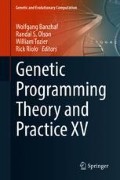Abstract
Previous work proposed a fast one-class anomaly detector using an ensemble of random half-space partitioning trees. The method was shown to be effective and efficient for detecting anomalies in streaming data. However, the parameters were pre-defined, so the random partitions of the data space might not be optimal. Therefore, the aims of this study were to: (a) give some mathematical analysis of the random partitioning trees; and (b) explore optimizing forests for anomaly detection using evolutionary algorithms.
Access this chapter
Tax calculation will be finalised at checkout
Purchases are for personal use only
References
Charu C Aggarwal. Outlier analysis. Springer Science & Business Media, 2013.
Markus M Breunig, Hans-Peter Kriegel, Raymond T Ng, and Jörg Sander. Lof: identifying density-based local outliers. In ACM Sigmod Record, volume 29, pages 93–104. ACM, 2000.
João BD Cabrera, Carlos Gutiérrez, and Raman K Mehra. Ensemble methods for anomaly detection and distributed intrusion detection in mobile ad-hoc networks. Information Fusion, 9(1):96–119, 2008.
Varun Chandola, Arindam Banerjee, and Vipin Kumar. Anomaly detection: A survey. ACM computing surveys (CSUR), 41(3):15, 2009.
Jiawei Han, Jian Pei, and Micheline Kamber. Data mining: concepts and techniques. Elsevier, 2011.
James A Hanley and Barbara J McNeil. The meaning and use of the area under a receiver operating characteristic (roc) curve. Radiology, 143(1):29–36, 1982.
Victoria J Hodge and Jim Austin. A survey of outlier detection methodologies. Artificial Intelligence Review, 22(2):85–126, 2004.
Huaming Huang, Kishan Mehrotra, and Chilukuri K Mohan. Rank-based outlier detection. Journal of Statistical Computation and Simulation, 83(3):518–531, 2013.
Wen Jin, Anthony KH Tung, Jiawei Han, and Wei Wang. Ranking outliers using symmetric neighborhood relationship. In Advances in Knowledge Discovery and Data Mining, pages 577–593. Springer, 2006.
Rajeev Motwani and Prabhakar Raghavan. Randomized algorithms. Chapman & Hall/CRC, 2010.
Swee Chuan Tan, Kai Ming Ting, and Tony Fei Liu. Fast anomaly detection for streaming data. In IJCAI Proceedings-International Joint Conference on Artificial Intelligence, volume 22, page 1511, 2011.
Jian Tang, Zhixiang Chen, Ada Wai-Chee Fu, and David W Cheung. Enhancing effectiveness of outlier detections for low density patterns. In Advances in Knowledge Discovery and Data Mining, pages 535–548. Springer, 2002.
Lena Tenenboim-Chekina, Lior Rokach, and Bracha Shapira. Ensemble of feature chains for anomaly detection. In Multiple Classifier Systems, pages 295–306. Springer, 2013.
Zhiruo Zhao, Kishan G Mehrotra, and Chilukuri K Mohan. Ensemble algorithms for unsupervised anomaly detection. In Current Approaches in Applied Artificial Intelligence, pages 514–525. Springer, 2015.
Zhiruo Zhao, Chilukuri K. Mohan, and Kishan G. Mehrotra. Adaptive sampling and learning for unsupervised outlier detection. In Proceedings of the Twenty-Ninth International Florida Artificial Intelligence Research Society Conference, FLAIRS 2016, Key Largo, Florida, May 16–18, 2016, pages 460–466, 2016.
Arthur Zimek, Matthew Gaudet, Ricardo JGB Campello, and Jörg Sander. Subsampling for efficient and effective unsupervised outlier detection ensembles. In Proceedings of the 19th ACM SIGKDD international conference on Knowledge discovery and data mining, pages 428–436. ACM, 2013.
Author information
Authors and Affiliations
Corresponding author
Editor information
Editors and Affiliations
Rights and permissions
Copyright information
© 2018 Springer International Publishing AG, part of Springer Nature
About this paper
Cite this paper
Zhao, Z., Card, S.W., Mehrotra, K.G., Mohan, C.K. (2018). Evolution of Space-Partitioning Forest for Anomaly Detection. In: Banzhaf, W., Olson, R., Tozier, W., Riolo, R. (eds) Genetic Programming Theory and Practice XV. Genetic and Evolutionary Computation. Springer, Cham. https://doi.org/10.1007/978-3-319-90512-9_11
Download citation
DOI: https://doi.org/10.1007/978-3-319-90512-9_11
Published:
Publisher Name: Springer, Cham
Print ISBN: 978-3-319-90511-2
Online ISBN: 978-3-319-90512-9
eBook Packages: Computer ScienceComputer Science (R0)

